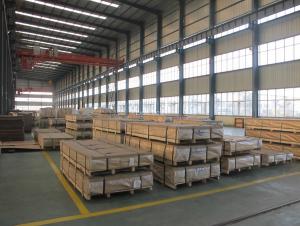Stainless Steel Cold Rolled Sheet Stocks
- Loading Port:
- Shanghai
- Payment Terms:
- TT or LC
- Min Order Qty:
- 4 m.t.
- Supply Capability:
- 5000 m.t./month
OKorder Service Pledge
OKorder Financial Service
You Might Also Like
1.Structure of Product Description
the product name is called stainless steel sheet, which can including cold rolled steel sheeet, hot rolled sheet, etc. which are widely used in the field of construction and decoration, etc.
There are many different grades, such as: 201, 202, 301, 304, 316, 410, 420, 430, etc.
The surface is including 2B, BA, Mirror Finish, Checkered, etc.
2. Main features of the product
a. Competitive price
c. Shortest service.
3. Image.
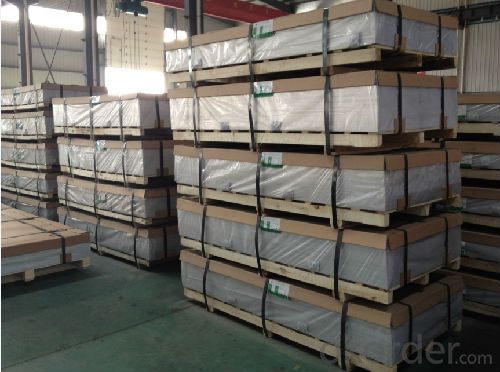
4. Product detailed sizes:
1000mm*2000mm, 1219mm*2438mm,1220mm*2440mm, 1250mm*2500mm,1500mm*3000mm, etc.
5. FAQ:
What is the quality standard?
---Usually our standard is GB3880-2006 or else.
What is the width range?
---It is from 1000mm to 2500mm, etc.
What is the length range?
---It is from 2000mm to 6000mm, etc.
What is the MOQ for your products yet?
---Normally it is around 3 tons/each size.
What is your mainly products?
---Normally they are stainless steel sheet, stainless steel coil, stainless steel checkered sheet, stainless steel mirror finished sheet, color coated stainless steel sheet, etc.
- Q: Can stainless steel sheets be used for backsplashes?
- Yes, stainless steel sheets can be used for backsplashes. Stainless steel is a popular choice for backsplashes due to its durability, resistance to heat and moisture, and easy maintenance. It can handle the heat and moisture that is often present in kitchen areas, making it a suitable material for protecting walls behind stovetops and sinks. Additionally, stainless steel backsplashes can add a modern and sleek look to the kitchen, complementing various design styles. They are also easy to clean, as they can be wiped down with a damp cloth or cleaned with mild soap and water. Overall, stainless steel sheets are a practical and aesthetic choice for backsplashes in both residential and commercial settings.
- Q: How do you prevent distortion when welding stainless steel sheets?
- To prevent distortion when welding stainless steel sheets, there are several key steps and precautions that should be followed: 1. Proper preparation: Ensure that the stainless steel sheets are clean and free from any contaminants such as oil, grease, or dirt. Thoroughly clean the surfaces using a suitable solvent or degreaser before welding. This helps to prevent any impurities from being trapped in the weld, which can lead to distortion. 2. Proper fit-up: Accurate fit-up of the stainless steel sheets is crucial to minimize distortion. Ensure that the edges of the sheets are aligned properly and that there are no gaps or misalignments. Proper clamping or tacking can also help to maintain the correct position of the sheets during welding. 3. Controlled heat input: Heat control is essential to prevent excessive distortion. Using the appropriate welding technique, such as TIG (Tungsten Inert Gas) or MIG (Metal Inert Gas), can help control the heat input. It is important to avoid overheating the stainless steel sheets as it can lead to warping and distortion. Maintaining a consistent and controlled heat input throughout the welding process is crucial. 4. Weld sequence: Proper planning of the weld sequence can also help to minimize distortion. Start from the center and work outward in a balanced manner to distribute the heat evenly. This prevents localized heating, which can cause distortion. Alternating between sides and allowing each weld to cool before moving to the next one can also help to reduce distortion. 5. Proper welding technique: Choosing the right welding technique and parameters is important. For instance, using a lower heat input, slower travel speed, and smaller weld bead can minimize distortion. Additionally, using a backstep technique, where the weld travels in a forward and backward motion, can help distribute the heat and reduce distortion. 6. Preheating and post-weld treatment: Preheating the stainless steel sheets can help reduce the temperature gradient and minimize distortion. The preheating temperature should be within the recommended range for the specific stainless steel grade. After welding, it is advisable to perform post-weld treatment, such as stress relieving, to minimize residual stresses that can lead to distortion. By following these steps and precautions, it is possible to significantly reduce distortion when welding stainless steel sheets. However, it is important to note that each welding process and stainless steel grade may have specific requirements, so referring to the manufacturer's guidelines and seeking professional advice is recommended for optimal results.
- Q: Are stainless steel sheets suitable for outdoor sculptures or decorative pieces?
- Outdoor sculptures or decorative pieces can be made using stainless steel sheets. Stainless steel is a material that is both durable and resistant to corrosion, making it perfect for enduring harsh outdoor conditions. It does not rust, corrode, or stain, meaning it will maintain its attractive appearance over time. Moreover, stainless steel sheets can be easily shaped and welded into different forms, allowing artists to create intricate and detailed sculptures or decorative pieces. Additionally, stainless steel has a sleek and modern look that can enhance the overall beauty of outdoor spaces. In conclusion, stainless steel sheets are an excellent option for outdoor sculptures or decorative pieces because of their durability, resistance to corrosion, and aesthetic appeal.
- Q: Are stainless steel sheets resistant to fire?
- Stainless steel sheets possess a remarkable ability to withstand fire. This is due to the fact that stainless steel is a type of metal alloy that contains a significant amount of chromium. When exposed to air or moisture, chromium forms a protective layer of chromium oxide on the surface. This layer acts as a barrier, preventing oxygen from reaching the underlying metal. As a result, stainless steel is highly resistant to corrosion and fire. Stainless steel sheets have an impressive melting point of approximately 2750°F (1510°C). This temperature is considerably higher than what is typically encountered in most fire situations. Consequently, stainless steel can endure intense heat for an extended period without losing its shape or structural integrity. Additionally, stainless steel is non-combustible and does not contribute to the spread of flames. It does not emit harmful gases or toxic fumes when exposed to fire. Therefore, stainless steel is a safe material for various applications where fire resistance is crucial, such as in building construction, industrial equipment, and transportation. Given these characteristics, stainless steel sheets are extensively used in structures with fire ratings, including fire doors, fire-rated walls, and fire-resistant enclosures. They serve as effective barriers against heat and flames, containing the fire and safeguarding the surrounding areas. However, it is important to note that while stainless steel is highly resistant to fire, it can still be affected by extremely high temperatures or prolonged exposure to fire. In such cases, the material may undergo some level of distortion or damage. Hence, it is essential to consider the specific fire rating requirements and seek advice from experts to ensure the proper selection and installation of stainless steel sheets in fire-resistant applications.
- Q: What are the different methods of cutting stainless steel sheets?
- There are several methods available for cutting stainless steel sheets, depending on the specific requirements and desired precision. 1. Shearing: This is one of the most common methods used for cutting stainless steel sheets. It involves using a shearing machine with sharp blades to cut through the material. Shearing is ideal for straight cuts and is relatively fast and cost-effective. 2. Laser cutting: Laser cutting is a highly precise method that uses a high-powered laser beam to cut through stainless steel sheets. It provides a clean and smooth cut, and can be used to create intricate designs or complex shapes. Laser cutting is widely used in industries that require high precision and quality finishes. 3. Plasma cutting: Plasma cutting uses a high-temperature plasma arc to melt through stainless steel sheets. This method is suitable for cutting thick stainless steel sheets or materials with high conductivity. Plasma cutting offers fast cutting speeds and can handle various shapes and thicknesses. 4. Waterjet cutting: Waterjet cutting involves using a high-pressure jet of water mixed with abrasive particles to cut through stainless steel sheets. This method is highly versatile and can create complex shapes with high precision. Waterjet cutting is also a cold cutting process, which means it does not produce heat-affected zones or alter the material's structure. 5. Abrasive cutting: This method uses an abrasive wheel or disc to grind and cut through stainless steel sheets. It is commonly used for rough cuts or in situations where other methods are not feasible. Abrasive cutting can be done manually or with the help of power tools, such as angle grinders. Each of these cutting methods has its own advantages and limitations, and the choice of method depends on factors such as the thickness of the stainless steel sheet, desired precision, budget, and production requirements.
- Q: Can stainless steel sheets be recycled after use?
- Yes, stainless steel sheets can be recycled after use. Stainless steel is a highly recyclable material, and the recycling process helps conserve natural resources and reduce waste.
- Q: Are stainless steel sheets suitable for escalator claddings?
- Indeed, escalator claddings can be effectively adorned with stainless steel sheets. With its durability and resistance to corrosion, stainless steel emerges as an exceptional option for heavily frequented zones such as escalators. Moreover, its effortless cleaning and maintenance are of utmost significance in public areas. Furthermore, stainless steel's sleek and contemporary appearance has the potential to elevate the overall aesthetic of the escalator.
- Q: How do you polish stainless steel sheets?
- To polish stainless steel sheets, you can follow a few simple steps. First, ensure that the surface is clean and free from any dirt or debris. You can use a mild detergent or stainless steel cleaner to remove any stains or marks. Next, use a soft cloth or sponge to apply a stainless steel polish or a combination of vinegar and olive oil. Apply the polish in the direction of the grain, which is usually a linear pattern on the surface of stainless steel. Once the polish is applied, use another clean cloth to buff the surface in the same direction as the grain. Apply gentle pressure and continue buffing until the stainless steel sheets start to shine and appear polished. If necessary, repeat the process in areas that require additional polishing, and ensure that all excess polish is wiped away to avoid streaks or residue. It is important to note that different stainless steel finishes may require specific polishing techniques or products. Always refer to the manufacturer's instructions or guidelines for best results.
- Q: Can stainless steel sheets be used for stadium seating?
- Certainly! Stadium seating can indeed utilize stainless steel sheets. This particular material boasts durability and resistance against corrosion, rendering it a fitting choice for outdoor purposes such as stadium seating. It can endure various weather conditions, be it rain, snow, or harmful UV rays, without succumbing to deterioration or rust. By manipulating stainless steel sheets, one can fashion them into diverse seating structures, thus presenting a robust and enduring seating solution for stadiums. Furthermore, stainless steel possesses an appealing aesthetic and can be finished in numerous manners to elevate its visual allure, thereby contributing to the stadium's overall design.
- Q: Can stainless steel sheets be used in the automotive industry?
- Indeed, the automotive industry does have the capability to employ stainless steel sheets. Owing to their remarkable strength, durability, and resistance to corrosion, stainless steel is frequently utilized in the assembly of automotive components. Exhaust systems, fuel tanks, bumpers, and trim are common examples of parts that are often crafted from this material. The utilization of stainless steel sheets grants manufacturers a great deal of flexibility in terms of design options, enabling them to fashion intricate forms and structures. Furthermore, due to its aesthetic appeal and ease of upkeep, stainless steel remains a favored choice in the automotive industry.
Send your message to us
Stainless Steel Cold Rolled Sheet Stocks
- Loading Port:
- Shanghai
- Payment Terms:
- TT or LC
- Min Order Qty:
- 4 m.t.
- Supply Capability:
- 5000 m.t./month
OKorder Service Pledge
OKorder Financial Service
Similar products
Hot products
Hot Searches
Related keywords


















